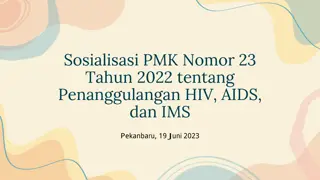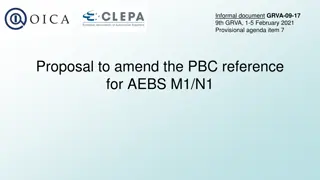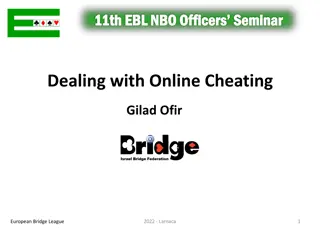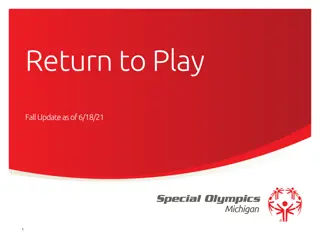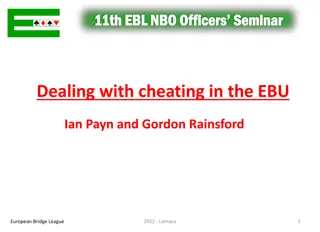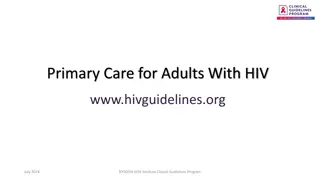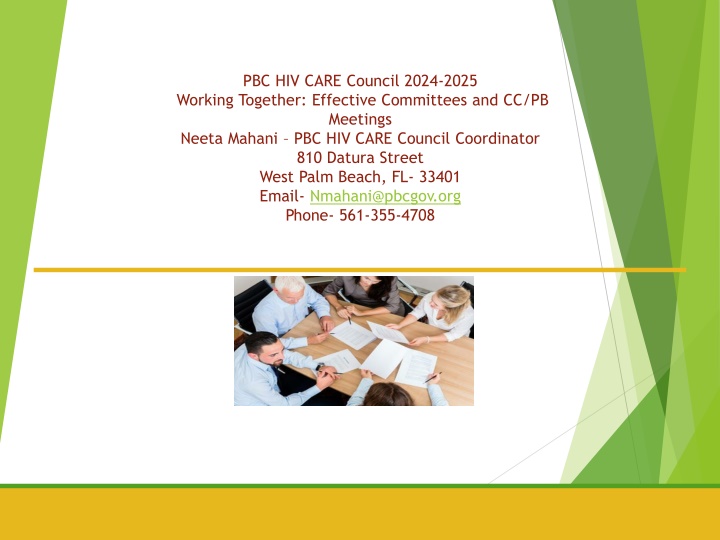
Effective Committees and CC/PB Meetings: Roles and Responsibilities
Discover the essential roles and responsibilities of chairs in successful committee and CC/PB meetings. Learn how to plan, facilitate, and ensure the effectiveness of these crucial gatherings to enhance collaboration and decision-making within the council. Gain insights on leadership roles, officer training, and HRSA/HAB expectations to support a productive and inclusive environment.
Download Presentation

Please find below an Image/Link to download the presentation.
The content on the website is provided AS IS for your information and personal use only. It may not be sold, licensed, or shared on other websites without obtaining consent from the author. If you encounter any issues during the download, it is possible that the publisher has removed the file from their server.
You are allowed to download the files provided on this website for personal or commercial use, subject to the condition that they are used lawfully. All files are the property of their respective owners.
The content on the website is provided AS IS for your information and personal use only. It may not be sold, licensed, or shared on other websites without obtaining consent from the author.
E N D
Presentation Transcript
PBC HIV CARE Council 2024-2025 Working Together: Effective Committees and CC/PB Meetings Neeta Mahani PBC HIV CARE Council Coordinator 810 Datura Street West Palm Beach, FL- 33401 Email- Nmahani@pbcgov.org Phone- 561-355-4708
Topic 1: CC/PB Operations Importance of Operations Working Effectively in Committees Successful CC/PB meetings
Role of the Chair in Successful Meetings Recognize the importance of meetings Work closely with CC support staff to plan the meeting Help develop and fully understand the agenda Be sure needed materials are provided and where possible projected during the discussion Be sure materials that might be needed for reference (e.g., Bylaws, policies & procedures) are readily available 1. 2. 3. 4. 5.
Role of the Chair, cont. Be sure meetings are open, accessible & welcoming, and provide an opportunity for public comment Establish and consistently enforce a Code of Conduct for everyone present Manage and facilitate the meeting set a positive, tone, maintain order, and encourage active participation Learn from experience ask for advice in improving meetings 10. Help ensure that minutes are completed, reviewed, approved, and posted promptly 6. 7. 8. 9.
Topic 2: Preparing and Supporting CC/PB Officers Leadership Roles Skills for Officers Officer Training and Support 5
Training Objectives Following the training, participants will be able to: Describe the typical responsibilities of CC/PB and committee Chairs, Co-Chairs, and Vice Chairs Identify at least 4 key knowledge areas for CC/PB officers Identify at least 4 important skills for officers as CC/PB leaders Describe the types of orientation and training typically needed by CC/PB officers Describe a process and strategies for providing orientation and ongoing training and support for PC/PB officers, including new leaders 1. 2. 3. 4. 5.
CC/PB Leadership Roles HRSA/HAB Expectations for Officers Officer Roles
Who Are the CC/PB Officers? CC/PB Chair, Co-Chairs, and/or Vice-Chairs Committee Chairs, Co-Chairs, and/or Vice- Chairs Sometimes other PC/PB officers elected or appointed: Secretary Treasurer Executive Committee typically includes most or all officers Usually includes at least one officer from each committee May also include at-large members, often consumers
HRSA/HAB Expectations for CC/PB Chairs/Co- Chairs The PC/PB may not be chaired solely by an employee of the recipient [p 148] The Chair may be appointed by the CEO or elected by the CC/PB [p 103] Chairs/Co-Chairs must reside within the boundaries of the EMA/TGA [p 120] Chairs/Co-Chairs benefit from development of skills for facilitation and how to chair a successful meeting [p 244] Part A Manual
HRSA/HAB Expectations for CC/PB Chair/Vice-Chairs, cont. Sign the letter of assurance (CC) or concurrence (PB) included in the annual Part A application [p 51] At meetings, help ensure that everyone is heard, the agreed-upon process for running meetings is followed, and time limits are placed on discussion [p 206] Review and certify the accuracy of the detailed minutes of each CC/PB meeting [p 95] Help review and manage conflict of interest [p 151] Part A Manual
Differentiating Chair, and Vice- Chair Roles Chair the leader of the CC/PB or committee, elected or appointed Vice-Chair the number two leader of the CC/PB or committee, who fills in for the Chair when needed and carries out assignments from the Chair Sometimes automatically becomes the next Chair
Typical Roles for CC/PB Chairs Develop meeting agendas Chair and facilitate meetings Assign tasks to committees Ensure that the agreed-upon meeting process, policies and procedures, and agenda are followed Request needed support: data, staffing Set deadlines and timelines and monitor progress on work plan Help direct the work of the CC/PB support manager May also: Establish work groups or committees Appoint members to committees
Typical Roles for Committee Chairs Develop committee agendas Chair and facilitate committee meetings Ensure that the agreed-upon meeting process, policies and procedures, and agenda are followed Work with CC/PB support staff to plan committee meetings and identify data, materials, staffing needs Ensure development of committee work plan and monitor progress/timelines Ensure training & mentoring for committee members Help prepare/review work products/reports Work collaboratively with other committees Represent/report for the committee at Executive Committee and PC/PB meetings
Typical Roles for Vice-Chairs Share all the roles of the Chair Often means: Chairing meetings every other month For CC/PB Vice-Chairs Monitoring the work of committees, with half the committees assigned to each Co-Chair Sharing or dividing other roles, such as representing the CC/PB in the community
Typical Roles for CC/PB or Committee Vice-Chairs Chair the CC/PB or committee or carry out other tasks when the Chair is absent or unavailable Carry out assignments on behalf of the Chair Attend meetings of assigned committees Represent the CC/PB or committee externally Chair a subcommittee or work group Become Chair or Acting Chair if a Chair leaves the CC/PB before completing the term Prepare for becoming the Chair when the current Chair terms out part of succession planning
Quick Activity H: Chairs and Vice-Chairs Your CC/PB has always had a Chair and a Vice-Chair, and the Vice- Chair almost always becomes the next Chair. However, 2 recent Chairs have left the CC/PB before the end of their terms. One Vice-Chair had received very little training or mentoring before taking on the new role the Chair was very engaged and didn t delegate anything. Your current Chair just got a new job and says it s just too much to do all the work alone. In addition, you have only had 1 consumer Chair or Vice-Chair in the past 6 years. Several members are urging changes to the Bylaws so that 1 of the 2 top officers is always a consumer or other PLWH. What are the benefits and disadvantages of Vice-Chairs? What might the CC/PB do and why?
Roles of PC/PB Officers in Engaging Members Help recruit members, sometimes including non-CC/PB members Orient, train, and help mentor new members Motivate members to participate/contribute actively Provide a welcoming environment for members Identify concerns/problems that may negatively affect member participation and help find solutions
Actions for Officers to Avoid Holding a meeting when there are no tasks to complete Making decisions without consulting PC/PB or committee members Favoring some members over others or allowing a few members to dominate discussion Allowing unlimited discussion Making any member feel uninformed or unvalued If parliamentary procedure is in use: Advocating for a particular decision while chairing a PC/PB meeting Voting except when there is a tie
Skills for Officers Knowledge Areas Skill Areas
Quick Activity I: Skills for CC/PB Leaders Based on your experience in HIV community planning: What are the 2-3 most important skills for a CC/PB Chair or Vice-Chair? 1. What are the most important skills for a CC/PB committee Chair or Vice- Chair? 2. If they are different, why? 3.
CC/PB Officer Knowledge Areas RWHAP: RWHAP legislation, guidance, and history especially Part A Your EMA/TGA and Part A Program: Local epidemic, recipient agency, integrated/comprehensive plan, system of care, service priorities & funding allocations, service expenditures, HIV care continuum (linkage to care, retention in care, viral suppression), PLWH service needs, barriers, and gaps CC/PB governance/operations: Bylaws, polices & procedures, committees, meeting rules and process, staffing. CC/PB membership: Roster, vacancies, representation and reflectiveness, open nominations process CC/PB status and plans: Annual calendar, CC/PB & committee work plans & status
CC/PB Officer Skill Areas HIV community planning: Organizing and implementing key planning tasks, especially legislative roles of CC/PB Communications: especially oral, but also concise written communications Meeting rules/procedures: Using your CC/PB s meeting chosen method of running meetings Recipient relations: Working productively with recipient staff
CC/PB Skill Areas, cont. Leadership and group process as needed to: Chair and facilitate meetings Work well with members from diverse cultures & backgrounds Motivate, engage, and support members Manage public comment and input Establish and maintain a high-performing team Analyze and resolve conflicts and other group-process issues Implement truly inclusive planning
Oral Communications Roles and Skills for Running a Meeting Communicate: Start the meeting, welcome new members, make introductions, address agenda, set the scene Control: Maintain control, manage time, be flexible but keep to the agenda Coax: Encourage full participation without anyone dominating; ask hard questions & raise hard issues Compare: Summarize various views presented Clarify: Make sure everyone understands the discussion, and control jargon and technical terms
Oral Communications Roles and Skills for Running a Meeting, cont. Support decision making: Ensure that decisions are made and that they reflect the CC/PB s purposes, and ensure that decisions are recorded and have someone assigned to implement them Guide: Remember your role in guiding the meeting, helping members work as a productive team, and managing time End the meeting: Summarize decisions made, follow-up action needed, and focus items for the next meeting
Officer Training and Support Initial Orientation and Training Strategies for Training and Supporting Officers
Training and Support for CC/PB Officers All officers should receive orientation immediately after election/appointment Officers chosen to fill a vacated seat should receive immediate orientation New officers or officers who are relatively new CC/PB members should be offered additional orientation All officers should receive additional training during their terms as a group, based on roles, or as individuals Executive Committee meetings provide an opportunity for brief updates/training if all officers serve on that committee
Components of Initial Orientation & Training General orientation should provide information on topics important for all officers, like: Officer roles/position descriptions HRSA/HAB expectations for CC/PBs and officers CC/PB governance documents (Bylaws, policies and procedures) CC/PB annual work plan Role of officers with regard to the recipient Responsibilities for consumer engagement Expectations for officer collaboration CC/PB staff support for officers Training should cover skills like group process, team building, and planning/managing meetings
Suggested Strategies for Training and Supporting CC/PB Leaders Orientation: Provide a structured, interactive orientation for new members immediately after their election, & before they chair their first meeting Self-assessments: Ask all new officers self-assess their knowledge & skills and identify most- needed orientation, training, and materials Officer Development Plan: Prepare a concise but specific Officer Development Plan for the CC/PB each year that includes shared and individual needs and provides strategies and a timeline for planned officer development opportunities 1. 2. 3.
Sample Format for an Annual Officer Development Plan Timeline/ Responsi- bility Type of Opportunity and Topics Targeted Participants [Check as applicable] Strategies/ Methods All CC/PB Officer s Com- mittee Officers Indivi- duals (Names) Officer s Orientation Session(s) [List topics] Training Sessions [List topics] Individual Development [List topics] Other Opportunities [List topics]
Strategies for Training and Supporting CC/PB Leaders, cont. Budgeting of funds for officer development: Set aside some CC/PB support funds for officer training & support 4. Access to materials: Be sure all officers have quick access to needed documents 5. Use of Executive Committee meetings: Set aside time during Executive Committee meetings for quick, focused training session & information updates 6.
Strategies for Training and Supporting CC/PB Leaders, cont. Periodic sessions: Hold periodic training and consultation sessions for all officers or all committee and work group officers, to learn new tools, share experience, and address identified information or skill development needs 7. Mentoring: Arrange for former CC/PB officers or appropriate staff to serve as mentors or advisors to new officers, formally or informally 8.
Strategies for Training and Supporting CC/PB Leaders, cont. Continuing support from CC/PB support staff: Ensure access to needed information and materials, logistical and administrative assistance, and advice for meeting planning and follow up and for successful completion of other tasks 9.
Strategies for Training and Supporting CC/PB Leaders, cont. Other officer development: Think creatively in arranging other opportunities for officer development; for example: Attendance at meetings or conferences that provide training, & sharing of new skills & tools with other officers Observation of other HIV or other types of planning bodies that provide useful models by attending personally or through electronic means Debriefings, including member feedback Use of online training on group process or team building Access to materials & tools on leadership & group process 10.
External Resources for CC/PB Officer Training and Support: Project Planning CHATT Planning Council Primer 2018 update Part A Manual 2022 update especially: Section X. Planning Council Operations Section XI. Planning and Planning Bodies PC/PB Training Guide
Sum Up CC/PBs vary in the number and types of officers, their roles, and how they are selected As the CC/PB s leaders, both CC/PB and Committee officers need orientation, training, and support Work Group also need training & support Officers need a variety of knowledge and skills Training needs are greatest for new officers, but veteran officers also benefit from training and can mentor others CC/PBs benefit from implementing a structured process of officer orientation, training, and development opportunities
Neeta Mahani Ryan White CARE Council Coordinator 810 Datura Street West Palm Beach, Florida 33401 Direct (561) 355-4820 Email Nmahani@pbcgov.org

